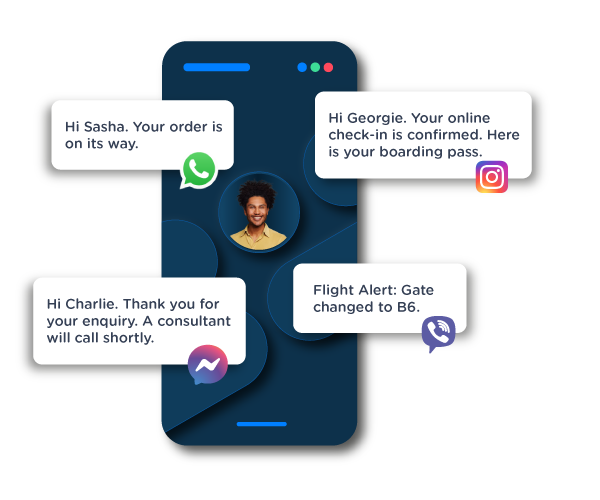- Decisions… Decisions…
- How Do I Choose the Right Channel?
- Incoming!
- The Power of One
- Should I Choose At All?
- Summary
Decisions… Decisions…
SMS used to be the standard to send mobile messages. Nowadays, you can also reach people via channels like WhatsApp, Facebook Messenger, Viber, Telegram, and the list goes on. You can even extend traditional SMS with rich messages using solutions like Pages. There are so many options; the sky seems to be the limit.
New messaging channels appear and each channel has its own characteristics. Different channels have different features, different regulations, they are governed by different legislation, use different keys to reach a specific phone.
Some require you to pass a validation process while others are open to use for everyone. You can’t possibly invest in all channels that are out there. If you want to reach your (future) customers, you need to cater your solution specifically for your target audience.
How Do I Choose the Right Channel?
One of the biggest challenges in mobile marketing nowadays, is getting your message across to the right person at the right time. If you want your audience to notice your message and register it, ensure that the message is relevant to the recipient and is delivered via the channel the recipient prefers. Just sending loads of emails is not sufficient anymore.
The chosen channel should be able to carry the information you want to share. Will text suffice, or do you need images and videos as well? Do you want to provide navigational directions? Are you sending one-off messages or are you broadcasting huge personalized campaigns?
Do you want to start an in-channel conversation with your recipients? And would you like to even close a deal and perform a payment transaction without the end-user having to leave the conversation? The final and inarguably most important factor is whether your intended recipient is reachable via the channel.

App availability differs wildly, based on geography and demographics. Older users tend to prefer traditional SMS, while the younger generations hardly ever leave their favorite messaging application. Viber is well adopted in Eastern Europe, yet hardly ever seen in China. There, WeChat is the dominant application, like Plus Message in Japan or Facebook Messenger in the USA.
Incoming!
Many channels have two-way capabilities. Even though SMS offers inbound possibilities, this often came at a price for the end-user and as such, the number of incoming messages stayed low. With most new channels, inbound messages are free for the end-user. Also, they are accustomed to using their apps for two-way communications. For some channels, companies are obligated to reply within 24 hours. Some channels can only be used when the end-user initiates the conversation. All these different streams of messages, all these different interfaces, how can you manage all that and still keep your end-users satisfied?
The Power of One
Let’s face it. You can never find a single rich messaging channel guaranteed to reach all your intended recipients. There still are people who don’t have a smartphone or don’t have access to data.
And what happens when you need two channels to reach the majority of your audience, want to expand your business, or need to reach out to another audience than before, maybe also into another geographical region? You will have to adapt to other channels as well.
When you connect directly to one or two channels, you can develop the required software and connectors yourself. Yet, when you want to connect a new channel or need additional features, it’s back to the drawing board. A small addition could even require a complete overhaul of your entire codebase. Connecting to a well-catered CPaaS provider like CM.com can help you simplify your connection process.

The single web platform, offering multiple channels in a single environment, enables you to adapt your messages and marketing campaigns for specific situations, without the need of custom development. Using proven API solutions, you can connect your own CRM system. You can even take it a step further and add CM.com’s Customer Data Platform for highly personalized campaigns. And when none of the available rich text channels are available or suitable for your recipient, CM.com offers the ability to send end-users to a mobile-friendly landing page by sending a personalized link via an SMS message.
Should I Choose At All?
You might want to send a single type of message to a big group of recipients, spread over multiple channels. You could split your recipients into several groups, one for each channel.
However, it could be much more convenient to use a supplier like CM.com, which enables you to send a message to all your recipients via all available channels. Our system can determine which channel is available for each recipient and send the message via the most appropriate system, eventually falling back to a plain SMS message or even a text-to-speech voice call.
Summary
There are lots of messaging channels. Each channel has its own pros and cons, and each audience has a different channel preference. To select the correct channel, you have to evaluate your needs and decide what channel best matches their needs. When using a CPaaS provider like CM.com, you can conveniently target many or even multiple channels at once and reach a bigger portion of your audience than when aiming for a single connection.
Being a fully equipped CPaaS provider, CM.com can help you with this as well. Mobile Service Cloud connects all applicable channels into one inbox for your support agents to communicate with your customers. By adding intelligent chatbots in the same application, and handing them over to human agents when needed, you can save costs on support personnel, stay compliant and still give your end-users a frictionless experience.
